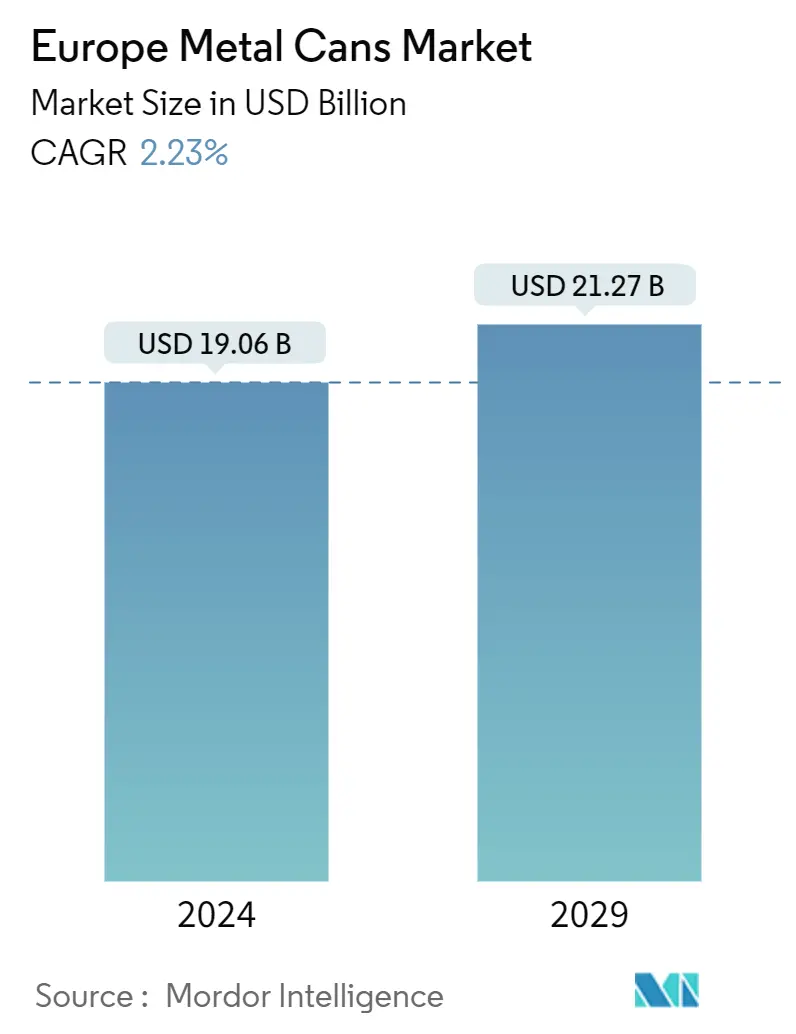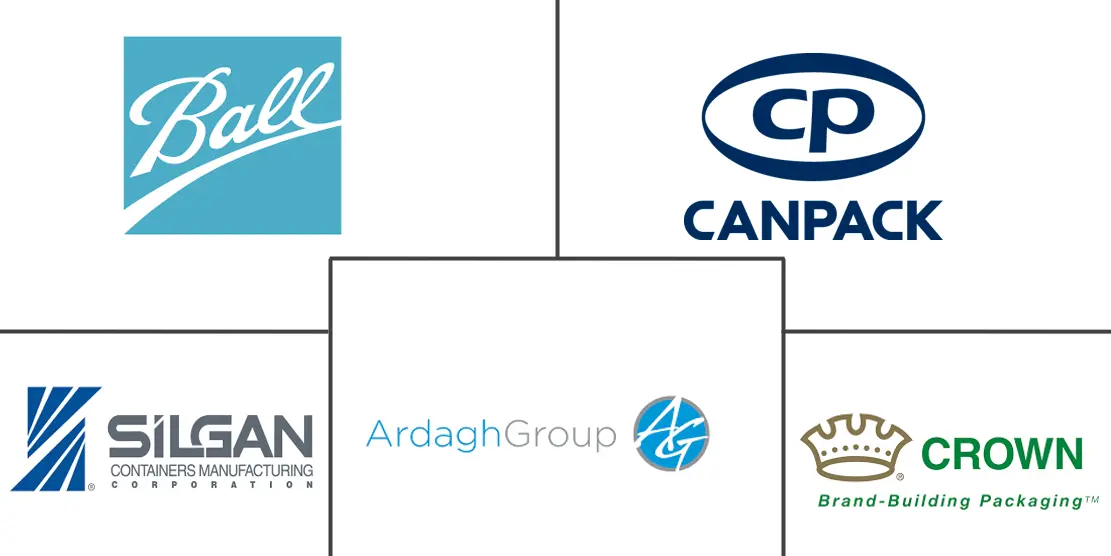Market Size of Europe Metal Cans Industry

| Study Period | 2019 - 2029 |
| Base Year For Estimation | 2023 |
| Market Size (2024) | USD 19.06 Billion |
| Market Size (2029) | USD 21.27 Billion |
| CAGR (2024 - 2029) | 2.23 % |
| Market Concentration | Low |
Major Players
*Disclaimer: Major Players sorted in no particular order |
Europe Metal Cans Market Analysis
The Europe Metal Cans Market size is estimated at USD 19.06 billion in 2024, and is expected to reach USD 21.27 billion by 2029, growing at a CAGR of 2.23% during the forecast period (2024-2029).
Metal cans' recyclable properties drive the market as making products from recycled metals uses less energy, reduces carbon emissions, and uses less water than raw materials. Some metals, especially aluminum, are so profitable to recycle that companies pay people and businesses for their used metal. According to Waste Care Corporation, recycled aluminum cans alone generate approximately USD 800 million annually. In Europe, companies are contributing to more sustainability by recycling aluminum.
- The capacity to recycle beverage cans is another advantage for the environment. Beverage cans are the recycling champions in Germany, where up to 99.1% of packaging is recycled. The aluminum can be repeatedly melted into new items, including bicycle frames and aircraft parts. The metal uses 95% less energy during multi-recycling than primary manufacture, ensuring the best recycling circuit. Metal cans are well-positioned for expansion in the European packaging industry due to their high recycling capacity and environmental benefits. The metal can packaging market is projected to grow as a sustainable and preferred option for packaging materials due to improved consumer awareness, regulatory backing, circular economy activities, brand reputation concerns, and chances for innovation.
- Due to growing environmental concerns, metal cans are increasingly preferred over plastic and glass containers. One of the main factors influencing the market examined in the area is the strong recycling potential of metal cans, the region's economic situation, and the low cost of canned foods. Metal is the most recycled packaging, with 73% of aluminum beverage cans and 85.5% of steel packaging recycled in Europe, according to metal packaging.
- However, the presence of alternate packaging solutions is restraining the market from growing, as the replacement possibility of polymer-based packaging materials, including polyethylene and polyethylene terephthalate (PET), is witnessing a challenge in the metal can usage.
- Members of Metal Packaging Europe supported the strong measures taken by the national governments and the European Commission to stop the spread of the COVID-19 pandemic. They were committed to guaranteeing the supply of metal packaging, abiding by the strictest safety and hygiene rules for food & beverage, hygiene, medical, and other essential goods throughout Europe. Further, the Russia-Ukraine war includes an impact on the overall packaging ecosystem.
Europe Metal Cans Industry Segmentation
The metal can is a container for storing goods, and it is composed of thin metal, which is prominently growing for use in food and beverage packaging. Changing lifestyles, raising alcoholic and non-alcoholic beverage requirements, rising disposable income, and rising need for processed foods are marking this market growth. They are generally used in the storage and distribution of food items. Metal cans are made up of aluminum, steel, and tin-coated steel. They are witnessing increasing application in Europe's food and beverage packaging industry.
The Europe metal cans market is segmented by material type (aluminum and steel), type (food cans (vegetables, fruits, pet food, soups & condiments, and other food cans (baby food, dairy, fruit/vegetable juices, seafood, and meat and poultry cans)), beverage cans (alcoholic and non-alcoholic), aerosol cans (personal care & cosmetics, household & homecare, and other aerosol cans), and other cans), and country (United Kingdom, Germany, France, Spain, Italy, Poland, and rest of Europe). The market sizes and forecasts are provided in value (USD) for all the above segments.
| Material Type | |
| Aluminum | |
| Steel |
| Type | |||||||
| |||||||
| |||||||
| |||||||
| Other Cans |
| Country | |
| United Kingdom | |
| Germany | |
| France | |
| Spain | |
| Italy | |
| Poland | |
| Rest of Europe |
Europe Metal Cans Market Size Summary
The Europe metal cans market is poised for steady growth, driven by the increasing demand for sustainable packaging solutions. Metal cans, particularly aluminum, are favored for their high recyclability and lower environmental impact compared to plastic and glass alternatives. The market benefits from strong consumer awareness and regulatory support for circular economy initiatives, which enhance the appeal of metal cans as a preferred packaging choice. The ongoing shift towards environmentally friendly packaging is further bolstered by the economic advantages of recycling metals, which require significantly less energy and resources than producing new materials. This trend is particularly evident in countries like Germany, where recycling rates for beverage cans are exceptionally high, underscoring the region's commitment to sustainability.
In the United Kingdom, the demand for metal cans is fueled by rising incomes, urbanization, and changing consumer lifestyles that prioritize convenience and portability. The popularity of small-size and multi-pack formats in the food sector, along with the growing interest in vegan and plant-based products, supports the expansion of metal cans. The online grocery sector's growth, especially in Germany, is expected to further drive the demand for metal cans as more consumers seek packaged foods and beverages. Additionally, the cosmetic and automotive industries in the UK contribute to the market's growth, with aerosol and lubricating grease cans gaining traction. Despite the competitive landscape and the presence of alternative packaging solutions, the metal cans market in Europe is well-positioned for continued expansion, supported by strategic acquisitions and product innovations by key industry players.
Europe Metal Cans Market Size - Table of Contents
-
1. MARKET INSIGHTS
-
1.1 Market Overview
-
1.2 Industry Attractiveness - Porter's Five Forces Analysis
-
1.2.1 Bargaining Power of Suppliers
-
1.2.2 Bargaining Power of Consumers
-
1.2.3 Threat of New Entrants
-
1.2.4 Threat of Substitutes
-
1.2.5 Intensity of Competitive Rivalry
-
-
1.3 Assessment of the Impact of COVID-19 on the Market
-
1.4 Market Drivers
-
1.4.1 High Recyclability Rates of Metal Packaging
-
-
1.5 Market Challenge
-
1.5.1 Presence of Alternate Packaging Solutions
-
-
-
2. MARKET SEGMENTATION
-
2.1 Material Type
-
2.1.1 Aluminum
-
2.1.2 Steel
-
-
2.2 Type
-
2.2.1 Food Cans
-
2.2.1.1 Vegetables
-
2.2.1.2 Fruits
-
2.2.1.3 Pet Food
-
2.2.1.4 Soups and Condiments
-
2.2.1.5 Other Food Cans (Baby Food, Dairy, Fruit/Vegetable Juices, Seafood, and Meat and Poultry Cans)
-
-
2.2.2 Beverage Cans
-
2.2.2.1 Alcoholic
-
2.2.2.2 Non-Alcoholic
-
-
2.2.3 Aerosol Cans
-
2.2.3.1 Personal care and Cosmetics
-
2.2.3.2 Household and Homecare
-
2.2.3.3 Other Aerosol Cans
-
-
2.2.4 Other Cans
-
-
2.3 Country
-
2.3.1 United Kingdom
-
2.3.2 Germany
-
2.3.3 France
-
2.3.4 Spain
-
2.3.5 Italy
-
2.3.6 Poland
-
2.3.7 Rest of Europe
-
-
Europe Metal Cans Market Size FAQs
How big is the Europe Metal Cans Market?
The Europe Metal Cans Market size is expected to reach USD 19.06 billion in 2024 and grow at a CAGR of 2.23% to reach USD 21.27 billion by 2029.
What is the current Europe Metal Cans Market size?
In 2024, the Europe Metal Cans Market size is expected to reach USD 19.06 billion.

